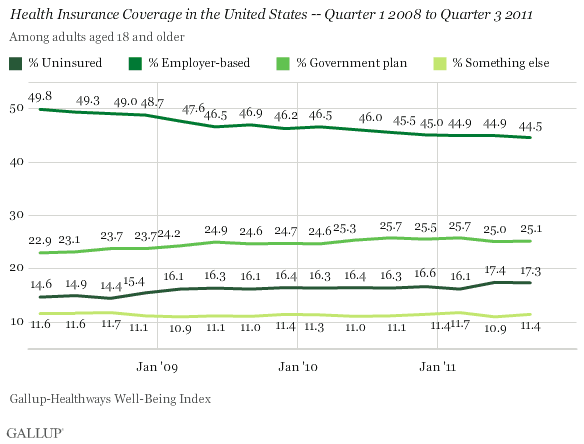WASHINGTON, D.C. -- The percentage of American adults who get their health insurance from an employer continues to decline, falling to 44.5% in the third quarter of this year. This percentage has been steadily declining since Gallup and Healthways started tracking Americans' health insurance sources in 2008.

At least 45% of Americans got their health insurance from an employer in every month in 2010, compared with more than 46% in 2009 and more than 48% in 2008. Initially, the percentage reporting they have employer-based health insurance seemed to be decreasing as unemployment and underemployment increased. However, it is likely that other factors -- including fewer employers offering health insurance -- are also contributing to this trend.
The percentage of adults with no health insurance has been increasing in 2011, with the 17.3% who were uninsured last quarter statistically tying the second quarter of this year for the highest on record. The increase in the percentage of uninsured Americans in the second quarter of 2011 coincides with Gallup's decision to include surveying more cell phone-only respondents in the U.S. beginning April 1. Thus, some of the increase in the uninsured could reflect the greater representation of cell phone-only respondents -- who tend to be younger (young adults are more likely to be uninsured) -- in Gallup samples.
While the percentage of 18- to 26-year-olds who lack health insurance has declined, there has been an increase among 25- to- 64-year-olds -- who make up a much larger segment of the population -- without health insurance. Young adults are likely benefiting from the provision in the new healthcare law that lets them stay on their parents' health plans until age 26. However, none of the other components of the health law that have already been implemented -- tax credits to help small businesses provide health insurance to their employees and the establishment of a Pre-Existing Condition Insurance Plan among several others -- appear to be affecting coverage for older adults.
Gallup initially found an increase in the percentage of Americans who were uninsured in the fourth quarter of 2008, as the effects of the financial crisis took hold and unemployment began to rise. Since then, the uninsured rate has remained elevated.
The percentage of Americans who get their health insurance from the government -- Medicare, Medicaid, or military/veterans' benefits -- declined somewhat in the second and third quarters of 2011, after increasing through most of 2010 and in the first quarter of this year. However, the percentage of Americans with government health insurance remains significantly higher than in 2008. The increase in government health insurance has occurred in tandem with the increasing percentage of Americans without health insurance and the decreasing percentage who get coverage from their employer.
Bottom Line
The health insurance system in the United States is experiencing numerous changes. Governments and businesses have and will continue to cut back and/or reform their health coverage offerings to handle tough economic circumstances, rising healthcare costs, and requirements of the Affordable Care Act.
The nation's largest private employer, Wal-Mart, announced in October that new part-time employees who work less than an average of 24 hours a week would no longer be able to get their health insurance from the company. Wal-Mart laid out several other cuts to its health insurance offerings, including some workers' ability get coverage for their spouses. Other companies have already made and will likely continue to make similar changes to their health insurance benefits.
Employer-based health insurance has declined since 2008, falling from 49.8% in the first quarter of that year to 44.5% in the third quarter of 2011. If Wal-Mart's decision is a precursor of how employers intend to manage their healthcare costs, the downward trend in employer-based healthcare will likely continue.
At the same time, the percentage of Americans who are uninsured is on the rise again after remaining fairly steady throughout 2010. If more employers stop offering health insurance and the cost of purchasing insurance for individuals remains a barrier, it is possible that the uninsured rate will continue to rise -- at least until additional parts of the 2010 healthcare legislation take effect.
About the Gallup-Healthways Well-Being Index
The Gallup-Healthways Well-Being Index tracks well-being in the U.S., U.K., and Germany and provides best-in-class solutions for a healthier world. To learn more, please visit well-beingindex.com.
Survey Methods
Results are based on telephone interviews conducted as part of the Gallup-Healthways Well-Being Index survey July 1-Sept. 30, 2011, with a random sample of 90,070 adults, aged 18 and older, living in all 50 U.S. states and the District of Columbia, selected using random-digit-dial sampling.
For results based on the total sample of national adults, one can say with 95% confidence that the maximum margin of sampling error is ±1 percentage point.
Interviews are conducted with respondents on landline telephones and cellular phones, with interviews conducted in Spanish for respondents who are primarily Spanish-speaking. Each sample includes a minimum quota of 400 cell phone respondents and 600 landline respondents per 1,000 national adults, with additional minimum quotas among landline respondents by region. Landline telephone numbers are chosen at random among listed telephone numbers. Cell phone numbers are selected using random-digit-dial methods. Landline respondents are chosen at random within each household on the basis of which member had the most recent birthday.
Samples are weighted by gender, age, race, Hispanic ethnicity, education, region, adults in the household, and phone status (cell phone only/landline only/both, cell phone mostly, and having an unlisted landline number). Demographic weighting targets are based on the March 2010 Current Population Survey figures for the aged 18 and older non-institutionalized population living in U.S. telephone households. All reported margins of sampling error include the computed design effects for weighting and sample design.
In addition to sampling error, question wording and practical difficulties in conducting surveys can introduce error or bias into the findings of public opinion polls.
For more details on Gallup's polling methodology, visit www.gallup.com.
